 IAS on Facebook IAS on Facebook
 IAS on Instagram IAS on Instagram

|

IAS Aroid Quasi Forum
About Aroid-L
This is a continuously updated archive of the Aroid-L mailing list in a forum format - not an actual Forum. If you want to post, you will still need to register for the Aroid-L mailing list and send your postings by e-mail for moderation in the normal way.
|
Does anyone know this Philodendron?
|
From: ExoticRainforest <Steve at ExoticRainforest.com> on 2009.07.15 at 04:44:56(19521)
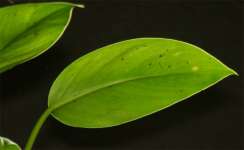
I've had this Philo for at leastthree years, likely more, and have no idea what it might be or where itoriginated. I've taken the plant to Dr. Croat in St. Louis and heappears to believe it is fully grown but has no idea what it might be. I've also sent these photos to several aroid botanists with noresults. Both the blades and the pot in the photo are approximately15 cm (6 inches) and the entire plant is small. I grow it inmoderately bright light but have never seen an inflorescence. I'veincluded photos of both the adaxial and abaxial blade surfaces (upperand lower), the petioles and stem. If any of you grow it or know whereit originated I would appreciate the info.
Thanks!
Steve Lucas
| HTML +More | |
www.ExoticRainforest.com
--------------030408010805000409010707 |
|
From: hermine <hermine at endangeredspecies.com> on 2009.07.15 at 18:11:55(19529)
At 09:44 PM 7/14/2009, you wrote:
I've had this Philo for at leastthree years, likely more, and have no idea what it might be or where itoriginated.
It's sort of like not cannifolium! but it is also veryattractive.
herm
| HTML +More | |
--=====================_98807515==.ALT----==============�07860510225073114=� |
|
From: "Elizabeth Campbell" <desinadora at mail2designer.com> on 2009.07.15 at 20:35:59(19530)
Steve, the one above the Anthurium bicolor in this photo is very similar. I'm back in Mindo in October and I can take a closer look at the plant if you wish. At the time, I think I just though "oh, another one of those lanceolate Philos" and was much more interested in the Anthurium.
Photo is at the link below
http://s256.photobucket.com/albums/hh196/HabloPorArboles/Aroids%20A%20Go-Go/?action=view¤t=DSCN8546.jpg
Beth
| HTML +More | |
_______________________________________________________________
Get the Free email that has everyone talking at http://www.mail2world.com
Unlimited Email Storage – POP3 – Calendar – SMS – Translator – Much More!------=_NextPart_000_2056_01CA0551.3032DCD0----==============h39831408555715594=� |
|
From: "Elizabeth Campbell" <desinadora at mail2designer.com> on 2009.07.15 at 20:39:15(19531)
Yeah, I just had a closer look at my archives, and I have a picture of what looks like your plant, growing all on its lonesome, Steve. Mindo-Nambillo Protected Forest, 1200 meters of elevation, Pichincha Province.
http://s256.photobucket.com/albums/hh196/HabloPorArboles/Aroids%20A%20Go-Go/?action=view¤t=DSCN8661.jpg
Beth
| HTML +More | |
_______________________________________________________________
Get the Free email that has everyone talking at http://www.mail2world.com
Unlimited Email Storage – POP3 – Calendar – SMS – Translator – Much More!------=_NextPart_000_2E2F_01CA0551.A563A020----==============�81099830580190538=� |
|
From: ExoticRainforest <Steve at ExoticRainforest.com> on 2009.07.15 at 20:55:46(19532)
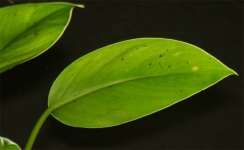
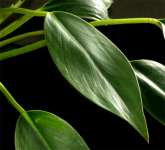
Ireceived this note today from aroid botanist Simon Mayo at the RoyalBotanic Garden Kew in London. Simon has spent a lot of time in Brazildoes not know it as well but I'd still like to know if any of you growit! Any info would help. For some reason I've always thought this isa Brazilian species but the tag telling where I got it was displacedlong ago.
Dear Steve,
It's still at thejuvenile monopodial growth stage because the leaf sheaths arewell-developed. Once it goes sympodial you should get leaves withvirtually no sheath alternating with prophylls that have two keels andno blade. It looks a bit as though it could turn into somethingresembling Ph. martianum, but at this juvenile stage it's hard todiagnose. It isn't trailing so it probably has a compact habit andstoutish stem with short internodes when mature. Possibly Brazil! Sorry I can't do better!
All the best
Simon
Steve Lucas
| HTML +More | |
www.ExoticRainforest.com
ExoticRainforest wrote:
I've had this Philo for at leastthree years, likely more, and have no idea what it might be or where itoriginated. I've taken the plant to Dr. Croat in St. Louis and heappears to believe it is fully grown but has no idea what it might be. I've also sent these photos to several aroid botanists with noresults. Both the blades and the pot in the photo are approximately15 cm (6 inches) and the entire plant is small. I grow it inmoderately bright light but have never seen an inflorescence. I'veincluded photos of both the adaxial and abaxial blade surfaces (upperand lower), the petioles and stem. If any of you grow it or know whereit originated I would appreciate the info.
Thanks!
Steve Lucas
www.ExoticRainforest.com
_______________________________________________Aroid-L mailing listAroid-L@www.gizmoworks.comhttp://www.gizmoworks.com/mailman/listinfo/aroid-l
--------------040809010802030001080901 |
|
From: Peter Boyce <phymatarum at googlemail.com> on 2009.07.16 at 01:15:21(19536)
Steve,
My mind turns towards P. pusillum or P. humile....
Pete
| HTML +More |
From:aroid-l-bounces@gizmoworks.com [mailto:aroid-l-bounces@gizmoworks.com] OnBehalf Of ExoticRainforest
Sent: 15 July 2009 12:45
To: Discussion of aroids
Subject: [Aroid-l] Does anyone know this Philodendron?
I've had thisPhilo for at least three years, likely more, and have no idea what it might beor where it originated. I've taken the plant to Dr. Croat in St. Louisand he appears to believe it is fully grown but has no idea what it mightbe. I've also sent these photos to several aroid botanists with noresults. Both the blades and the pot in the photo are approximately15 cm (6 inches) and the entire plant is small. I grow it in moderatelybright light but have never seen an inflorescence. I've included photosof both the adaxial and abaxial blade surfaces (upper and lower), the petiolesand stem. If any of you grow it or know where it originated I wouldappreciate the info.
Thanks!
Steve Lucas
www.ExoticRainforest.com
------=_NextPart_000_001E_01CA05F5.F6997920----==============w27784649949722676=� |
|
From: ExoticRainforest <Steve at ExoticRainforest.com> on 2009.07.16 at 03:16:30(19537)
Thanks Pete! I'll check out bothspecies and read all the characteristic details as possible.
Steve
| HTML +More | |
Peter Boyce wrote:
Steve,
Mymind turns towards P. pusillum or P. humile....
Pete
From:aroid-l-bounces@gizmoworks.com [mailto:aroid-l-bounces@gizmoworks.com] OnBehalf Of ExoticRainforest
Sent: 15 July 2009 12:45
To: Discussion of aroids
Subject: [Aroid-l] Does anyone know this Philodendron?
I'vehad thisPhilo for at least three years, likely more, and have no idea what itmight beor where it originated. I've taken the plant to Dr. Croat in St. Louisand he appears to believe it is fully grown but has no idea what itmightbe. I've also sent these photos to several aroid botanists with noresults. Both the blades and the pot in the photo are approximately15 cm (6 inches) and the entire plant is small. I grow it inmoderatelybright light but have never seen an inflorescence. I've includedphotosof both the adaxial and abaxial blade surfaces (upper and lower), thepetiolesand stem. If any of you grow it or know where it originated I wouldappreciate the info.
Thanks!
Steve Lucas
www.ExoticRainforest.com
_______________________________________________Aroid-L mailing listAroid-L@www.gizmoworks.comhttp://www.gizmoworks.com/mailman/listinfo/aroid-l
--------------020703050009010504070004 |
| |
|
From: ExoticRainforest <Steve at ExoticRainforest.com> on 2009.07.16 at 03:26:42(19539)
I have several Philodendronmartianum which is often called Philodendron cannifolium and thecharacteristics are not a good match. I wrote a very detailed pagewhich is on the site about a year ago with both Brazilian botanistMarcus Nadruz' and Leland Miyano's help on how P. martianum cameto be called P. cannifolium. Interesting story but technicallythere is no such plant as Philodendron cannifolium. http://www.exoticrainforest.com/Philodendron%20martianum%20pc.html
I'm now checking out Pete's suggestions! Thanks for the input.
Steve
| HTML +More |
hermine wrote:
At 09:44 PM 7/14/2009, you wrote:
I've had this Philo for at leastthree years, likely more, and have no idea what it might be or where itoriginated.
It's sort of like not cannifolium! but it is also veryattractive.
herm
_______________________________________________Aroid-L mailing listAroid-L@www.gizmoworks.comhttp://www.gizmoworks.com/mailman/listinfo/aroid-l
--------------060405060907060005040000 |
| |
|
From: ExoticRainforest <Steve at ExoticRainforest.com> on 2009.07.16 at 04:04:42(19541)
Pete, I just found Eduardo'spublished description of Philodendron pusillum and the driedmaterial looks a great deal like the blade and venation of this plant. I just sent him a note with the photos. I also checked out his Philodendronhumile but found virtually nothing. If any of you are interestedin reading and having a copy of his paper I've attached it in PDF formincluding photos. I'll also report back with his opinion as soon as Ireceive a response.
I'm planning on reading his entire paper in the morning!
Very good eyes Pete so thanks again!!
Steve Lucas
| HTML +More | |
www.ExoticRainforest.com
Peter Boyce wrote:
Steve,
Mymind turns towards P. pusillum or P. humile....
Pete
From:aroid-l-bounces@gizmoworks.com [mailto:aroid-l-bounces@gizmoworks.com] OnBehalf Of ExoticRainforest
Sent: 15 July 2009 12:45
To: Discussion of aroids
Subject: [Aroid-l] Does anyone know this Philodendron?
I'vehad thisPhilo for at least three years, likely more, and have no idea what itmight beor where it originated. I've taken the plant to Dr. Croat in St. Louisand he appears to believe it is fully grown but has no idea what itmightbe. I've also sent these photos to several aroid botanists with noresults. Both the blades and the pot in the photo are approximately15 cm (6 inches) and the entire plant is small. I grow it inmoderatelybright light but have never seen an inflorescence. I've includedphotosof both the adaxial and abaxial blade surfaces (upper and lower), thepetiolesand stem. If any of you grow it or know where it originated I wouldappreciate the info.
Thanks!
Steve Lucas
www.ExoticRainforest.com
_______________________________________________Aroid-L mailing listAroid-L@www.gizmoworks.comhttp://www.gizmoworks.com/mailman/listinfo/aroid-l
--------------020502060309070104070405 |
|
From: ExoticRainforest <Steve at ExoticRainforest.com> on 2009.07.16 at 04:07:49(19542)
Please allow me to correct myself! I found a copy of Eduardoand Josef's paper! I can't leave out a very prominent aroid botanist!!!
Steve
| HTML +More | |
Pete, I just found Eduardo'spublished description of Philodendron pusillum and the driedmaterial looks a great deal like the blade and venation of this plant. I just sent him a note with the photos. I also checked out his Philodendronhumile but found virtually nothing. If any of you are interestedin reading and having a copy of his paper I've attached it in PDF formincluding photos. I'll also report back with his opinion as soon as Ireceive a response.
I'm planning on reading his entire paper in the morning!
Very good eyes Pete so thanks again!!
Steve Lucas
www.ExoticRainforest.com
Peter Boyce wrote:
Steve,
Mymind turns towards P. pusillum or P. humile....
Pete
From: aroid-l-bounces@gizmoworks.com[mailto:aroid-l-bounces@gizmoworks.com] OnBehalf Of ExoticRainforest
Sent: 15 July 2009 12:45
To: Discussion of aroids
Subject: [Aroid-l] Does anyone know this Philodendron?
I'vehad thisPhilo for at least three years, likely more, and have no idea what itmight beor where it originated. I've taken the plant to Dr. Croat in St. Louisand he appears to believe it is fully grown but has no idea what itmightbe. I've also sent these photos to several aroid botanists with noresults. Both the blades and the pot in the photo are approximately15 cm (6 inches) and the entire plant is small. I grow it inmoderatelybright light but have never seen an inflorescence. I've includedphotosof both the adaxial and abaxial blade surfaces (upper and lower), thepetiolesand stem. If any of you grow it or know where it originated I wouldappreciate the info.
Thanks!
Steve Lucas
www.ExoticRainforest.com
_______________________________________________Aroid-L mailing listAroid-L@www.gizmoworks.comhttp://www.gizmoworks.com/mailman/listinfo/aroid-l
--------------060205060307030009080501 |
|
From: ExoticRainforest <Steve at exoticrainforest.com> on 2009.07.16 at 12:27:30(19544)
I received this response this morning from Dr. Eduardo Gonçalvesin Brazil. It appears this specimen is likely to be Philodendronpusillum from Colombia. After I read Eduardo's note I checked thebase of the stem and there is some reddishness. I've attaached thephoto. I've also read his and Josef's published description and theplant is a very good match.
Thanks a bunch Pete! It is great to have guys like you, Tom and allour other botanists on the forum to help solve these mysteries!
Steve Lucas
| HTML +More | |
www.ExoticRainforest.com
Dear Steve,
I really think thiscould be P.pusillum, from Colombia.Usually it is reddish at the base, but considering it is cultivated, alittlechange is expected. There is another species I described (P. humile),from Brazil,that is also small (inflorescences are up to 7 cm long) but hascordateleaf-blades.
Very best wishes,
Eduardo.
Peter Boyce wrote:
Steve,
Mymind turns towards P. pusillum or P. humile....
Pete
--------------020503060200030507020206 |
|
From: "Marek Argent" <abri1973 at wp.pl> on 2009.07.16 at 18:20:17(19549)
Hello,
I have photos of Philodendron martianum and it has swollen petioles
http://www.wschowa.com/abrimaal/araceum/philodendron/martianum.htm
Marek
| HTML +More | |
----- Original Message -----
From: ExoticRainforest
To: Discussion of aroids
Sent: Thursday, July 16, 2009 5:26 AM
Subject: Re: [Aroid-l] Does anyone know this Philodendron?
I have several Philodendron martianum which is often called Philodendron cannifolium and the characteristics are not a good match. I wrote a very detailed page which is on the site about a year ago with both Brazilian botanist Marcus Nadruz' and Leland Miyano's help on how P. martianum came to be called P. cannifolium. Interesting story but technically there is no such plant as Philodendron cannifolium. http://www.exoticrainforest.com/Philodendron%20martianum%20pc.html
I'm now checking out Pete's suggestions! Thanks for the input.
Steve
hermine wrote:
At 09:44 PM 7/14/2009, you wrote:
I've had this Philo for at least three years, likely more, and have no idea what it might be or where it originated.
It's sort of like not cannifolium! but it is also very attractive.
herm
_______________________________________________Aroid-L mailing listAroid-L@www.gizmoworks.comhttp://www.gizmoworks.com/mailman/listinfo/aroid-l
_______________________________________________
Aroid-L mailing list
Aroid-L@www.gizmoworks.com
http://www.gizmoworks.com/mailman/listinfo/aroid-l
Nie znaleziono wirusa w tej wiadomosci przychodzacej.
Sprawdzone przez AVG - www.avg.com
Wersja: 8.5.375 / Baza danych wirus�w: 270.13.13/2237 - Data wydania: 07/14/09 05:56:00
------=_NextPart_000_0118_01CA0652.D5855350----==============182899677383935994=� |
|
From: "Marek Argent" <abri1973 at wp.pl> on 2009.07.17 at 16:00:15(19558)
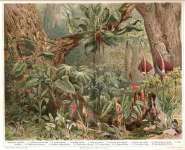
This is strange. I typed in the MoBot Tropicos database the name "Philodendron cannifolium" and the name is accepted,
http://www.tropicos.org/NameSearch.aspx
I googled for images and most of them show Ph. martianum or other popular species like Ph. sagittifolium or Ph. hastatum.
http://images.google.pl/images?gbv=2&hl=pl&safe=off&rlz=1B3GGGL_plPL306PL306&q=Philodendron+cannifolium&sa=N&start=18&ndsp=18
To mix up more: I have and ald lithography which presents a species Philodendron cannaefolium (see the attachment), there's no such entry in Tropicos, but I found a page showing this "species" and it is not Ph. martianum, it resembles Ph. hastatum ("glaucophyllum"):
http://www.desert-tropicals.com/Plants/Araceae/Philodendron_cannaefolium.html
Another page says that Ph. cannaefolium is a synonym of Ph. martianum, but there are no photos:
http://davesgarden.com/guides/pf/go/57521/
And a forum page with photos of Ph. martianum and a long discussion after it
http://www.ubcbotanicalgarden.org/forums/showthread.php?t=30838
Have fun
Marek
| HTML +More | |
----- Original Message -----
From: ExoticRainforest
To: Discussion of aroids
Sent: Friday, July 17, 2009 5:32 AM
Subject: Re: [Aroid-l] Does anyone know this Philodendron?
Correct Marek. The petioles which support each blade of Philodendron martianum are spongy to the touch. They commonly possess a "C" shaped depression (sulcate or canaliculate) down the adaxial (upper) surface and since the petiole's are often swollen they likely store water or starches inside. There are also sharp ridges that define the edges of the canal.
The plant in your photos appear to be those of a juvenile specimen. The largest plant on my page is very large and is in the collection of Leland Miyano in Hawaii. All the data on my page has also been checked by aroid botanist Marcus Nadruz and others but I'm always anxious to have any errors pointed out.
I've attached one of Leland's photos showing the size of the petioles of his plant. I thought I had added this to the page but just found I left it off. I'll add it later tonight.
http://www.exoticrainforest.com/Philodendron%20martianum%20pc.html
Steve Lucas
www.ExoticRainforest.com
Marek Argent wrote:
Hello,
I have photos of Philodendron martianum and it has swollen petioles
http://www.wschowa.com/abrimaal/araceum/philodendron/martianum.htm
Marek
----- Original Message -----
From: ExoticRainforest
To: Discussion of aroids
Sent: Thursday, July 16, 2009 5:26 AM
Subject: Re: [Aroid-l] Does anyone know this Philodendron?
I have several Philodendron martianum which is often called Philodendron cannifolium and the characteristics are not a good match. I wrote a very detailed page which is on the site about a year ago with both Brazilian botanist Marcus Nadruz' and Leland Miyano's help on how P. martianum came to be called P. cannifolium. Interesting story but technically there is no such plant as Philodendron cannifolium. http://www.exoticrainforest.com/Philodendron%20martianum%20pc.html
I'm now checking out Pete's suggestions! Thanks for the input.
Steve
l
_______________________________________________
Aroid-L mailing list
Aroid-L@www.gizmoworks.com
http://www.gizmoworks.com/mailman/listinfo/aroid-l
Nie znaleziono wirusa w tej wiadomosci przychodzacej.
Sprawdzone przez AVG - www.avg.com
Wersja: 8.5.375 / Baza danych wirus�w: 270.13.13/2237 - Data wydania: 07/14/09 05:56:00
------=_NextPart_001_013D_01CA0708.701EA5F0--------=_NextPart_000_013C_01CA0708.701E7EE0 |
|
From: ExoticRainforest <Steve at ExoticRainforest.com> on 2009.07.17 at 16:43:29(19562)
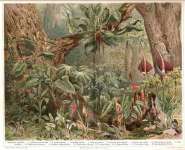
I ran into the same thing but if youread the page you'll see how we tracked down the info. We had to go toKew to get the real story. The problem appears to date back to VonMartius (for whom the plant was named) when he drew an exceptionaldrawing of the plant but called it Philodendron cannifolium. I thinkif you read the entire page you'll see how the information wasextracted. I had a great deal of difficulty understanding all of thisuntil Leland tracked down the Kew's info and we got Marcus involved.
Steve
| HTML +More | |
Marek Argent wrote:
This is strange. I typed in theMoBot Tropicos database the name "Philodendron cannifolium" and thename is accepted,
http://www.tropicos.org/NameSearch.aspx
I googled for images and most ofthem show Ph. martianum or other popular species like Ph. sagittifoliumor Ph. hastatum.
http://images.google.pl/images?gbv=2&hl=pl&safe=off&rlz�3GGGL_plPL306PL306&q=Philodendron+cannifolium&sa=N&start�&ndsp�
To mix up more: I have and aldlithography which presents a species Philodendron cannaefolium (see theattachment), there's no such entry in Tropicos, but I found a pageshowing this "species" and it is not Ph. martianum, it resembles Ph.hastatum ("glaucophyllum"):
http://www.desert-tropicals.com/Plants/Araceae/Philodendron_cannaefolium.html
Another page says that Ph.cannaefolium is a synonym of Ph. martianum, but there are no photos:
http://davesgarden.com/guides/pf/go/57521/
And a forum page with photos of Ph.martianum and a long discussion after it
http://www.ubcbotanicalgarden.org/forums/showthread.php?t0838
Have fun
Marek
-----Original Message -----
From: ExoticRainforest
To: Discussion of aroids
Sent:Friday, July 17, 2009 5:32 AM
Subject:Re: [Aroid-l] Does anyone know this Philodendron?
Correct Marek. The petioles which support eachblade of Philodendron martianum are spongy to the touch. They commonly possess a "C" shaped depression (sulcate orcanaliculate) down the adaxial (upper) surface and since the petiole'sare often swollen they likely store water or starches inside. Thereare also sharp ridges that define the edges of the canal.
The plant in your photos appear to be those of a juvenile specimen. The largest plant on my page is very large and is in the collection ofLeland Miyano in Hawaii. All the data on my page has also been checkedby aroid botanist Marcus Nadruz and others but I'm always anxious tohave any errors pointed out.
I've attached one of Leland's photos showing the size of the petiolesof his plant. I thought I had added this to the page but just found Ileft it off. I'll add it later tonight.
http://www.exoticrainforest.com/Philodendron%20martianum%20pc.html
Steve Lucas
www.ExoticRainforest.com
Marek Argent wrote:
Hello,
I have photos of Philodendronmartianum and it has swollen petioles
http://www.wschowa.com/abrimaal/araceum/philodendron/martianum.htm
Marek
-----Original Message -----
From: ExoticRainforest
To: Discussionof aroids
Sent:Thursday, July 16, 2009 5:26 AM
Subject:Re: [Aroid-l] Does anyone know this Philodendron?
I have several Philodendronmartianum which is often called Philodendron cannifolium and thecharacteristics are not a good match. I wrote a very detailed pagewhich is on the site about a year ago with both Brazilian botanistMarcus Nadruz' and Leland Miyano's help on how P. martianum cameto be called P. cannifolium. Interesting story but technicallythere is no such plant as Philodendron cannifolium. http://www.exoticrainforest.com/Philodendron%20martianum%20pc.html
I'm now checking out Pete's suggestions! Thanks for the input.
Steve
l
_______________________________________________
Aroid-L mailing list
Aroid-L@www.gizmoworks.com
http://www.gizmoworks.com/mailman/listinfo/aroid-l
Nie znaleziono wirusa w tej wiadomosci przychodzacej.
Sprawdzone przez AVG - www.avg.com
Wersja: 8.5.375 / Baza danych wirusów: 270.13.13/2237 - Data wydania:07/14/09 05:56:00
_______________________________________________Aroid-L mailing listAroid-L@www.gizmoworks.comhttp://www.gizmoworks.com/mailman/listinfo/aroid-l
--------------090608090402010301020807 |
|
From: ExoticRainforest <Steve at ExoticRainforest.com> on 2009.07.17 at 16:48:45(19563)
Marek, if you go this page on theKew's site and type in the name Philodendron cannifolium you'll findeven though it has been published the name is illegal.
http://apps.kew.org/wcsp/prepareChecklist.do;jsessionid�401C4F4D3E096297071B4049CFACD3?checklist=selected_families%40%40256120920080243474
As for the garden sites, I never trust them since they often repeat"plant myths". I have even found the same "myths" on the USDA's site.
Steve Lucas
| HTML +More | |
www.ExoticRainforest.com
Marek Argent wrote:
This is strange. I typed in theMoBot Tropicos database the name "Philodendron cannifolium" and thename is accepted,
http://www.tropicos.org/NameSearch.aspx
I googled for images and most ofthem show Ph. martianum or other popular species like Ph. sagittifoliumor Ph. hastatum.
http://images.google.pl/images?gbv=2&hl=pl&safe=off&rlz�3GGGL_plPL306PL306&q=Philodendron+cannifolium&sa=N&start�&ndsp�
To mix up more: I have and aldlithography which presents a species Philodendron cannaefolium (see theattachment), there's no such entry in Tropicos, but I found a pageshowing this "species" and it is not Ph. martianum, it resembles Ph.hastatum ("glaucophyllum"):
http://www.desert-tropicals.com/Plants/Araceae/Philodendron_cannaefolium.html
Another page says that Ph.cannaefolium is a synonym of Ph. martianum, but there are no photos:
http://davesgarden.com/guides/pf/go/57521/
And a forum page with photos of Ph.martianum and a long discussion after it
http://www.ubcbotanicalgarden.org/forums/showthread.php?t0838
Have fun
Marek
-----Original Message -----
From: ExoticRainforest
To: Discussion of aroids
Sent:Friday, July 17, 2009 5:32 AM
Subject:Re: [Aroid-l] Does anyone know this Philodendron?
Correct Marek. The petioles which support eachblade of Philodendron martianum are spongy to the touch. They commonly possess a "C" shaped depression (sulcate orcanaliculate) down the adaxial (upper) surface and since the petiole'sare often swollen they likely store water or starches inside. Thereare also sharp ridges that define the edges of the canal.
The plant in your photos appear to be those of a juvenile specimen. The largest plant on my page is very large and is in the collection ofLeland Miyano in Hawaii. All the data on my page has also been checkedby aroid botanist Marcus Nadruz and others but I'm always anxious tohave any errors pointed out.
I've attached one of Leland's photos showing the size of the petiolesof his plant. I thought I had added this to the page but just found Ileft it off. I'll add it later tonight.
http://www.exoticrainforest.com/Philodendron%20martianum%20pc.html
Steve Lucas
www.ExoticRainforest.com
Marek Argent wrote:
Hello,
I have photos of Philodendronmartianum and it has swollen petioles
http://www.wschowa.com/abrimaal/araceum/philodendron/martianum.htm
Marek
-----Original Message -----
From: ExoticRainforest
To: Discussionof aroids
Sent:Thursday, July 16, 2009 5:26 AM
Subject:Re: [Aroid-l] Does anyone know this Philodendron?
I have several Philodendronmartianum which is often called Philodendron cannifolium and thecharacteristics are not a good match. I wrote a very detailed pagewhich is on the site about a year ago with both Brazilian botanistMarcus Nadruz' and Leland Miyano's help on how P. martianum cameto be called P. cannifolium. Interesting story but technicallythere is no such plant as Philodendron cannifolium. http://www.exoticrainforest.com/Philodendron%20martianum%20pc.html
I'm now checking out Pete's suggestions! Thanks for the input.
Steve
l
_______________________________________________
Aroid-L mailing list
Aroid-L@www.gizmoworks.com
http://www.gizmoworks.com/mailman/listinfo/aroid-l
Nie znaleziono wirusa w tej wiadomosci przychodzacej.
Sprawdzone przez AVG - www.avg.com
Wersja: 8.5.375 / Baza danych wirusów: 270.13.13/2237 - Data wydania:07/14/09 05:56:00
_______________________________________________Aroid-L mailing listAroid-L@www.gizmoworks.comhttp://www.gizmoworks.com/mailman/listinfo/aroid-l
--------------050809060503010003050001 |
|
From: ExoticRainforest <Steve at exoticrainforest.com> on 2009.07.22 at 22:42:19(19585)
Pete, I just wanted to thank youagain for pointing me towards Philodendron pusillum as per myrequest on Aroid l for an ID on the species. Eduardo helped a greatdeal and I've created a brief page on the plant. The tag is long lostand I'm not even certain where it came from but it does appear to berare in collections according to Eduardo's material. I've tried toinclude photos that match to his and Josef's description but if you seeanything wrong please do point it out. I've also sent Eduardo the linkso he can tell me if he sees anything wrong.
I know I often get long winded in my own zeal to learn and scare peopleaway from reading my pages so I've intentionally kept this one brief. These pages are really just my personal notes to myself and I use themto remind myself of what I've been taught by guys like you, Eduardo,Tomand others. So thanks again for your help.
If anyone on this forum has managed to see an inflorescence on thisspecimen and have a photo I'd love to be able to use it, especially ifyou know what the fruit color is. That info was not included in thedescription and I'm not certain if it is known.
http://www.exoticrainforest.com/Philodendron%20pusillum%20pc.html
Steve Lucas
| HTML +More | |
www.ExoticRainforest.com
Peter Boyce wrote:
Steve,
Mymind turns towards P. pusillum or P. humile....
Pete
From:aroid-l-bounces@gizmoworks.com [mailto:aroid-l-bounces@gizmoworks.com] OnBehalf Of ExoticRainforest
Sent: 15 July 2009 12:45
To: Discussion of aroids
Subject: [Aroid-l] Does anyone know this Philodendron?
I'vehad thisPhilo for at least three years, likely more, and have no idea what itmight beor where it originated. I've taken the plant to Dr. Croat in St. Louisand he appears to believe it is fully grown but has no idea what itmightbe. I've also sent these photos to several aroid botanists with noresults. Both the blades and the pot in the photo are approximately15 cm (6 inches) and the entire plant is small. I grow it inmoderatelybright light but have never seen an inflorescence. I've includedphotosof both the adaxial and abaxial blade surfaces (upper and lower), thepetiolesand stem. If any of you grow it or know where it originated I wouldappreciate the info.
Thanks!
Steve Lucas
www.ExoticRainforest.com
_______________________________________________Aroid-L mailing listAroid-L@www.gizmoworks.comhttp://www.gizmoworks.com/mailman/listinfo/aroid-l
--------------060803000008050209000903 |
| |
Note: this is a very old post, so no reply function is available.
|
|







